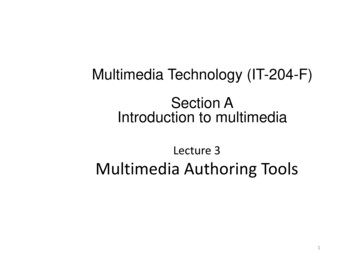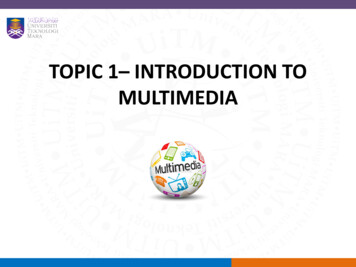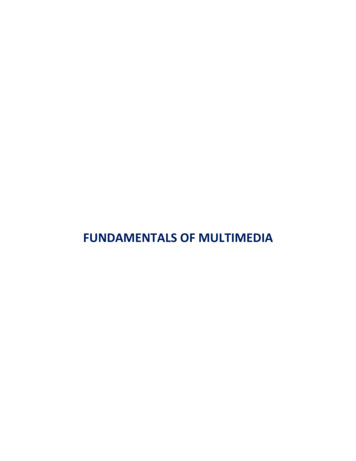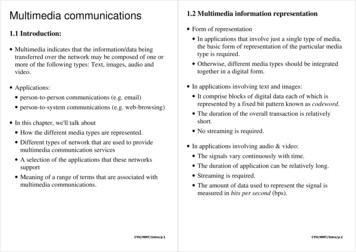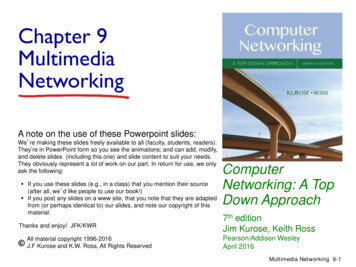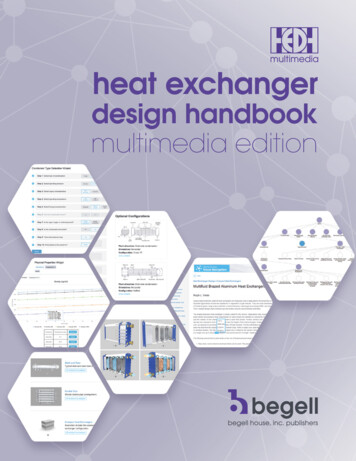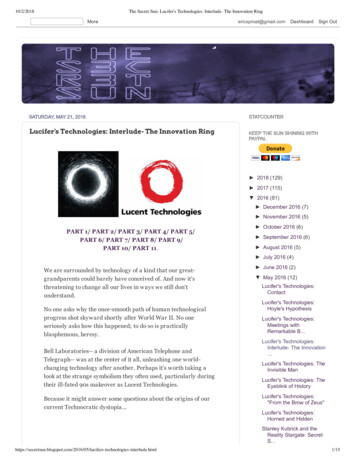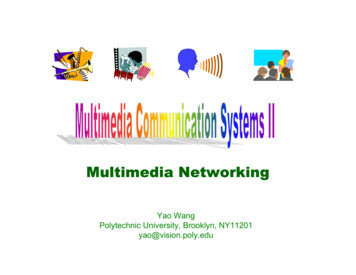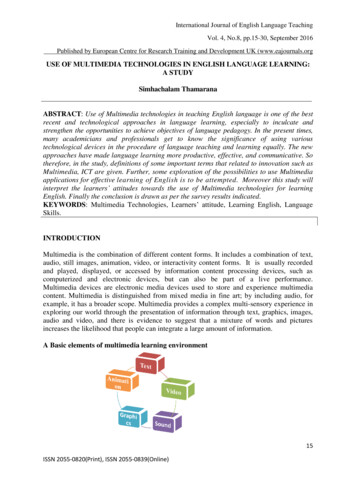
Transcription
International Journal of English Language TeachingVol. 4, No.8, pp.15-30, September 2016Published by European Centre for Research Training and Development UK (www.eajournals.orgUSE OF MULTIMEDIA TECHNOLOGIES IN ENGLISH LANGUAGE LEARNING:A STUDYSimhachalam ThamaranaABSTRACT: Use of Multimedia technologies in teaching English language is one of the bestrecent and technological approaches in language learning, especially to inculcate andstrengthen the opportunities to achieve objectives of language pedagogy. In the present times,many academicians and professionals get to know the significance of using varioustechnological devices in the procedure of language teaching and learning equally. The newapproaches have made language learning more productive, effective, and communicative. Sotherefore, in the study, definitions of some important terms that related to innovation such asMultimedia, ICT are given. Further, some exploration of the possibilities to use Multimediaapplications for effective learning of English is to be attempted. Moreover this study willinterpret the learners’ attitudes towards the use of Multimedia technologies for learningEnglish. Finally the conclusion is drawn as per the survey results indicated.KEYWORDS: Multimedia Technologies, Learners‟ attitude, Learning English, LanguageSkills.INTRODUCTIONMultimedia is the combination of different content forms. It includes a combination of text,audio, still images, animation, video, or interactivity content forms. It is usually recordedand played, displayed, or accessed by information content processing devices, such ascomputerized and electronic devices, but can also be part of a live performance.Multimedia devices are electronic media devices used to store and experience multimediacontent. Multimedia is distinguished from mixed media in fine art; by including audio, forexample, it has a broader scope. Multimedia provides a complex multi-sensory experience inexploring our world through the presentation of information through text, graphics, images,audio and video, and there is evidence to suggest that a mixture of words and picturesincreases the likelihood that people can integrate a large amount of information.A Basic elements of multimedia learning environment15ISSN 2055-0820(Print), ISSN 2055-0839(Online)
International Journal of English Language TeachingVol. 4, No.8, pp.15-30, September 2016Published by European Centre for Research Training and Development UK (www.eajournals.orgMultimedia can provide a large amount of instructional information to the students for thepurpose of English learning and accelerate the process of information searching. We can getsome related information from the large amount of information stored on the internet.REVIEW OF LITERATUREAll the kinds of technological tools that make us able to transmit information in a very largemeaning, leveraging the learning power of human senses and transforming information intoknowledge, stimulating the cognitive schemes of learners. The use of multimediatechnologies in educational institutions is seen as necessary for keeping education relevant tothe twenty-first century (Selwyn & Gordard, 2003). Educators have heralded the advent ofmultimedia technologies as a catalyst for change in traditional teaching practices; to innovateand improve on traditional practices (LeFoe, 1998; Relan & Gillani, 1997). One of theultimate goals of multimedia language teaching is to promote students‟ motivation andlearning interest, which can be a practical way to get them involved in the language learning(Thamarana, 2015). Advances in information and communication technologies, particularlythe Internet and interactive multimedia technologies, are creating new networkingopportunities for students. Technology-mediated mentoring is one way to bring to studentssubject matter experts that can give advice, feedback, and guidance (Kerka, 1998).Multimedia in education has the potential to go beyond the boundaries of interaction andexplorative learning. The actors in the education community could establish a „„VirtualEducation Space‟‟Context of the Problem:The issues of poor and ineffective learning of English language had been noticed amongundergraduate students in the collages of all the three north-costal districts in Andhra Pradesh,i.e. Visakhapatnam, Vizianagaram and Srikakulam. At present, there are many Multimediatechnologies such as Internet, YouTube, Instant Relay Messenger, Smart Phone, Projector,Television, E-books, Graphics, Mp3 Player, Video player and Animations. These technologieshave been contributing enormous to teaching and learning of English language effectively.Especially, Multimedia technologies are great source for language activities, material inteaching and learning English language. However, many students may not have the technicalskills to make full use of these technological resources. Therefore, this study investigates thelearners‟ attitudes towards the use of Multimedia technologies for learning English.Terminology(a) MultimediaMultimedia combines five basic types of media into the learning environment: text, video,sound, graphics and animation, thus providing a powerful new tool for education. Here in thisstudy, Multimedia refers to Graphics (Digital Images), Mp3 Players (Digital Audio Players),Video players (VCD, DVD players) and Animations.(b) Information Communication Technology16ISSN 2055-0820(Print), ISSN 2055-0839(Online)
International Journal of English Language TeachingVol. 4, No.8, pp.15-30, September 2016Published by European Centre for Research Training and Development UK (www.eajournals.orgICT covers any product that will store, retrieve, manipulate, and transmit or receiveinformation electronically in a digital form for example, personal computers, digitaltelevision, email and robots. Importantly, it is also concerned with the way these differentuses can work with each other.(c) AttitudeIt refers to affect and is an evaluative, emotional reaction (i.e., the degree of like, or dislikeassociated with attitudinal object.(d) PerceptionIt is defined as the participants‟ responses to each of the questionnaire which measures theparticipants‟ general feelings towards the usefulness of the ICT and Multimedia basedactivities in the English classroom. Here in this study, it refers to an individual‟s recognitionsof the events, his ways of seeing and understanding things, knowledge and information whichare drawn from their personal experiences in the case of English language learners.Aim of the Study(a) To study learners‟ attitudes towards multimedia technologies as non-traditional forms ofinstruction.Question of the Study(a) What is the learners’ attitude towards the use of Multimedia technologies?Hypothesis of the Study(a) There is no positive attitude of learners towards the use of Multimedia technologies.Limitations of the Study(i) The study was carried out for six weeks within the time constraints and the availability ofthe participants. This duration can be extended to three months in a year. This can relievethe pressure of time and the other responsibilities of the participants.DATA-GATHERING TECHNIQUECommon approaches to understanding perceptions include the use of questionnaires, focusgroups, and interviews.While each of these approaches provides good information,questionnaires may be the best way to assess perceptions because they can be completedanonymously and administered to assess changes in individuals‟ experiences and thinkingover time. A questionnaire is a system for collecting information to describe, compare, andexplain knowledge, attitudes, perceptions, or behaviour. Some Multimedia Technologies17ISSN 2055-0820(Print), ISSN 2055-0839(Online)
International Journal of English Language TeachingVol. 4, No.8, pp.15-30, September 2016Published by European Centre for Research Training and Development UK (www.eajournals.orgAttitude Questionnaires were used for this purpose. The questionnaire which is called„Students‟ Attitudes towards the Use of Multimedia technologies‟ contains 15 items. It wasdistributed among 320 Undergraduate Students. Responses were on a 5- point scale, rangingfrom “completely agree” to “completely disagree” (1 indicated a strong agreement with thestatement and 5 indicated a strong disagreement to the given statement). The questionnairestudies students‟ attitudes towards the use of Multimedia technologies in learning Englishlanguage.The purpose of this questionnaire is to collect information about students‟attitudes when learning English with the help of Multimedia technologies i.e. E-books (PDF,Epub.), Graphics (Digital Images), Mp3 Players (Digital Audio Players), Video players (VCD,DVD players) and Animations.Students’ Survey Description:The advantage of using such questionnaires is that they are less time consuming than someother data elicitation techniques such as interviews. Thus the students‟ questionnaire wasdesigned to collect the necessary information from various undergraduate students from thevarious degree colleges in three selected north-costal districts of Andhra Pradesh. So the firstsection and the second section of the students‟ questionnaire were particularly designed tostudy students‟ perceptions towards the use of Multimedia technologies in Englishlanguage learning. There are 15 questions in the Students‟ Attitudes Questionnaire.Analysis and InterpretationFor the data analysis, basic statistics were performed on the data extracted from thestudents‟ attitudes questionnaire. The extracted data were analyzed using the StatisticalPackage for the Social Sciences. The data collected were analyzed using a 0.05(alpha)significance level, p .05.Furthermore, this paper presents testing of the hypothesis as regards attitudes of EFL learnerstowards learning English through Multimedia technologies. The questionnaire was analyzedusing Mean, Standard deviation statistical procedures in the SPSS. This database was used tosum the numeric values of the responses. In addition, this database was used to runfrequencies, percentages, means, and standards of deviations. The mean score was used tojudge whether the overall students‟ attitude towards the use of Multimedia technologies werepositive or negative. The analysis of the responses provided the researcher with a generalidea about the students‟ understanding of multimedia technologies and particularly theirattitudes towards the use of multimedia technologies in learning English.Validity and Reliability of the QuestionnaireValidity is about asking the right questions to justify what the researcher get in the end.To determine if the survey was reliable, Cronbach‟s alpha coefficient of internal consistencywas calculated. This is a value between 0.0 and 1.0 that estimates the probability that if thesame survey was given to the same students, then the results would be the same.Anything greater than 0.7 is considered acceptable consistency. The alpha value for theoverall students‟ survey score is 0.818, so this is within the acceptable range.18ISSN 2055-0820(Print), ISSN 2055-0839(Online)
International Journal of English Language TeachingVol. 4, No.8, pp.15-30, September 2016Published by European Centre for Research Training and Development UK (www.eajournals.orgAnalysis of the Students’ Attitudes towards the use of Multimedia Technologies:Research Question“What is the students’ attitude towards the use of Multimedia technologies?”HypothesisThere is no positive attitude of students’ towards the use of Multimedia technologies.Item 1: I feel comfortable with the idea of using Multimedia as a learning tool in English.Table 01Comfortable with the idea of using MultimediaI feel comfortable with the idea of using Multimedia as a learningtool in EnglishCompletely Agree Agree Neutral Disagree Completely Disagree Total781342160GenderMale 63Female60811270160Total12315925112320Source: QuestionnaireFigure 01Comfortable with the idea of using MultimediaSource: Table 01Table 01 presents responses of the students under survey about the statement that the studentsfeels comfortable with the idea of using Multimedia as a learning tool for English. It is foundthat 38.44% respondents completely agreed with the statement that they feel comfortablewith the idea of using Multimedia as a learning tool. It is also found that 49.69% respondents19ISSN 2055-0820(Print), ISSN 2055-0839(Online)
International Journal of English Language TeachingVol. 4, No.8, pp.15-30, September 2016Published by European Centre for Research Training and Development UK (www.eajournals.orghave also shown their agreement with the statement under reference. However, 7.81%respondents have preferred to remain neutral in their opinion. Furthermore, incontradistinction, however, 3.44% respondents have indicated their disagreement with thestatement that they feel comfortable with the idea of using Multimedia as a learning tool forEnglish. It is noticeable that meagre 0.63% respondents completely disagreed with thestatement.To sum up, it is deduced that both male and female students under survey, the majority ofsample respondents agree with the idea that they feel comfortable with the idea of usingMultimedia as a learning tool for English.Item 2: The use of E-books in English learning is most advantages.Table 02Use of E-books in learning is advantageousGender MaleTotalThe use of E-books in English learning is most advantagesCompletelyCompletelyAgreeAgreeNeutral Disagree DisagreeTotal66622750160Female 5912568130245151044160320Source: QuestionnaireFigure 02Use of E-books in learning is advantageousSource: Table 02Table 02 presents responses of the students under survey about the statement that use of Ebooks in learning is most advantageous. It is found that 39.06% respondents completely20ISSN 2055-0820(Print), ISSN 2055-0839(Online)
International Journal of English Language TeachingVol. 4, No.8, pp.15-30, September 2016Published by European Centre for Research Training and Development UK (www.eajournals.orgagreed with the statement that the use of E-books in learning is most advantageous. It is alsofound that 40.63% respondents have also shown their agreement with the statement underreference. However, 15.94% respondents have preferred to remain neutral in their opinion.Furthermore, in contradistinction, however, 3.13% respondents have indicated theirdisagreement with the statement that the use of E-books in learning is most advantageous. Itis noticeable that meagre 1.25% respondents completely disagreed with the statement.To sum up, it is deduced that both male and female students under survey, the majority ofsample respondents agree with the idea that the use of E-books in learning is mostadvantageous.Item 3: The idea of using Mp3 Players in learning makes me confident.Table 03Use of Mp3 Players in learningThe idea of using Mp3 Players in learning makes meconfidentCompletelyCompletelyAgreeAgreeNeutral Disagree DisagreeTotal555625213160Gender MaleTotalFemale 5310865121295493047160320Source: QuestionnaireFigure 03Use of Mp3 Players in learningSource: Table 0321ISSN 2055-0820(Print), ISSN 2055-0839(Online)
International Journal of English Language TeachingVol. 4, No.8, pp.15-30, September 2016Published by European Centre for Research Training and Development UK (www.eajournals.orgTable 03 presents responses of the students under survey about the statement that the idea ofusing Mp3 Players in learning makes students confident. It is found that 33.75% respondentscompletely agreed with the statement that the idea of using Mp3 Players in learning makesstudents confident. It is also found that 37.81% respondents have also shown their agreementwith the statement under reference. However, 16.88% respondents have preferred to remainneutral in their opinion. Furthermore, in contradistinction, however, 9.38% respondents haveindicated their disagreement with the statement that the idea of using Mp3 Players in learningmakes them confident. It is noticeable that 2.19% respondents completely disagreed with thestatement.To sum up, it is deduced that both male and female students under survey, the majority ofsample respondents agree with the idea that the idea of using Mp3 Players in learning makesstudents confident.Item 4: The use of Animations as learning tool in English excites me.Table 04Use of Animations as an exciting learning toolGender MaleTotalThe use of Animations as learning tool in English excites meCompletelyCompletelyAgreeAgreeNeutral Disagree DisagreeTotal70681192160Female 65135681361526101924160320Source: QuestionnaireFigure 04Use of Animations as an exciting learning toolSource: Table 0422ISSN 2055-0820(Print), ISSN 2055-0839(Online)
International Journal of English Language TeachingVol. 4, No.8, pp.15-30, September 2016Published by European Centre for Research Training and Development UK (www.eajournals.orgTable 04 presents responses of the students under survey about the statement that the use ofthe Animations as instructional or learning tool excites them. It is found that 42.19%respondents completely agreed with the statement that the use of Animations as instructionalor learning tool excites them. It is also found that 42.50% respondents have also shown theiragreement with the statement under reference. However, 8.13% respondents have preferred toremain neutral in their opinion. Furthermore, in contradistinction, however, 5.94%respondents have indicated their disagreement with the statement that the use of Animationsas instructional or learning tool excites them. It is noticeable that meagre 1.25% respondentscompletely disagreed with the statement.To sum up, it is deduced that both male and female students under survey, the majority ofsample respondents agree with the idea that the use of Animations as instructional or learningtool excites the students.Item 5: The Video Player is a valuable learning tool for students.Table 05Video player as a valuable learning toolGender MaleFemaleTotalThe Video Player is a valuable learning tool for studentsCompletelyCompletelyAgreeAgreeNeutral Disagree 5Source: QuestionnaireFigure 05Video player as a valuable learning toolSource: Table 0523ISSN 2055-0820(Print), ISSN 2055-0839(Online)
International Journal of English Language TeachingVol. 4, No.8, pp.15-30, September 2016Published by European Centre for Research Training and Development UK (www.eajournals.orgTable 05 presents responses of the students under survey about the statement that the VideoPlayer is a valuable instructional tool for English. It is found that 33.44% respondentscompletely agreed with the statement that the Video Player is a valuable instructional tool forEnglish. It is also found that 39.06% respondents have also shown their agreement with thestatement under reference. However, 16.88% respondents have preferred to remain neutral intheir opinion. Furthermore, in contradistinction, however, 9.06% respondents have indicatedtheir disagreement with the statement that the Video Player is a valuable instructional tool forEnglish. It is noticeable that 1.56% respondents completely disagreed with the statement.To sum up, it is deduced that both male and female students under survey, the majority ofsample respondents agree with the idea that the Video Player is a valuable instructional toolfor English.Item 6: The use of Multimedia will change the way I learn.Table 06Multimedia provides new learning waysGender MaleFemaleTotalThe use of Multimedia will change the way ICompletelyAgreeAgreeNeutral 97331603205212139691730Source: QuestionnaireFigure 06Multimedia provides new learning waysSource: Table 0624ISSN 2055-0820(Print), ISSN 2055-0839(Online)
International Journal of English Language TeachingVol. 4, No.8, pp.15-30, September 2016Published by European Centre for Research Training and Development UK (www.eajournals.orgTable 06 presents responses of the students under survey about the statement that theMultimedia will change the way the students learn. It is found that 30.31% respondentscompletely agreed with the statement that the Multimedia will change the way the studentslearn. It is also found that 37.81% respondents have also shown their agreement with thestatement under reference. However, 21.56% respondents have preferred to remain neutral intheir opinion. Furthermore, in contradistinction, however, 9.38% respondents have indicatedtheir disagreement with the statement that the Multimedia will change the way the studentslearn. It is noticeable that meagre 0.94% respondents completely disagreed with thestatement.To sum up, it is deduced that both male and female students under survey, the majority ofsample respondents agree with the idea that the Multimedia will change the way the studentslearn.Item 7: The learning with the use of Graphics is more useful than traditional way of learning.Table 07Use of multimedia is more useful than traditional learning waysThe learning with the use of Graphics is more useful thantraditional way of reeDisagreeTotal6329122160Gender Male 54TotalFemale 6011470133184782046160320Source: QuestionnaireFigure 07Use of multimedia is more useful than traditional learning waysSource: Table 0725ISSN 2055-0820(Print), ISSN 2055-0839(Online)
International Journal of English Language TeachingVol. 4, No.8, pp.15-30, September 2016Published by European Centre for Research Training and Development UK (www.eajournals.orgTable 07 presents responses of the students under survey about the statement that the learningwith the use of Graphics is more useful than traditional ways of learning. It is found that35.63% respondents completely agreed with the statement that the learning with the use ofGraphics is more useful than traditional ways of learning. It is also found that 42.56%respondents have also shown their agreement with the statement under reference. However,14.69% respondents have preferred to remain neutral in their opinion. Furthermore, incontradistinction, however, 6.25% respondents have indicated their disagreement with thestatement that the learning with the use of Graphics is more useful than traditional ways oflearning. It is noticeable that meagre 1.88% respondents completely disagreed with thestatement.To sum up, it is deduced that both male and female students under survey, the majority ofsample respondents agree with the idea that the learning with the use of Graphics is moreuseful than traditional ways of learning.Item 8: The use of Multimedia helps me understand concepts in more effective ways.Table 08Multimedia helps teachers in presenting concepts effectivelyThe use of Multimedia helps me understand concepts in moreeffective waysCompletelyCompletelyAgreeAgreeNeutralDisagree DisagreeTotal67741450160Gender MaleTotalFemale 4210983157Source: QuestionnaireFigure cepts160320effectivelySource: Table 0826ISSN 2055-0820(Print), ISSN 2055-0839(Online)
International Journal of English Language TeachingVol. 4, No.8, pp.15-30, September 2016Published by European Centre for Research Training and Development UK (www.eajournals.orgTable 08 presents responses of the students under survey about the statement that the use ofMultimedia helps teachers in presenting concepts in a more effective manner. It is found that34.06% respondents completely agreed with the statement that the use of Multimedia helpsteachers in presenting concepts in a more effective manner. It is also found that 49.06%respondents have also shown their agreement with the statement under reference. However,11.25% respondents have preferred to remain neutral in their opinion. Furthermore, incontradistinction, however, 5.31% respondents have indicated their disagreement with thestatement that the use of Multimedia helps teachers in presenting concepts in a more effectivemanner. It is noticeable that meagre 0.31% respondents completely disagreed with thestatement.To sum up, it is deduced that both male and female students under survey, the majority ofsample respondents agree with the idea that the use of Multimedia helps teachers inpresenting concepts in a more effective manner.Item 9: The Multimedia helps students learn because it allows us to express our thinking inbetter and different ways.Table 09Multimedia helps in better thinking and learningGender MaleTotalThe Multimedia helps students learn because it allows us toexpress our thinking in better and different isagreeTotal78601462160Female 65143611211933111746160320Source: QuestionnaireFigure 09Multimedia helps in better thinking and learningSource: Table 0927ISSN 2055-0820(Print), ISSN 2055-0839(Online)
International Journal of English Language TeachingVol. 4, No.8, pp.15-30, September 2016Published by European Centre for Research Training and Development UK (www.eajournals.orgTable 09 presents responses of the students under survey about the statement that theMultimedia helps students learn because it allows us to express our thinking in better anddifferent ways. It is found that 44.69% respondents completely agreed with the statement thatthe Multimedia helps students learn because it allows us to express our thinking in better anddifferent ways. It is also found that 37.81% respondents have also shown their agreementwith the statement under reference. However, 10.31% respondents have preferred to remainneutral in their opinion. Furthermore, in contradistinction, however, 5.31% respondents haveindicated their disagreement with the statement that the Multimedia helps students learnbecause it allows us to express our thinking in better and different ways. It is noticeable thatmeagre 1.88% respondents completely disagreed with the statement.To sum up, it is deduced that both male and female students under survey, the majority ofsample respondents agree with the idea that the Multimedia helps students learn because itallows us to express our thinking in better and different ways.Item 10: The Multimedia helps learners to learn the language skills in more effective ways.Table 10Multimedia helps in learning language skills effectivelyThe Multimedia helps learners to learn the language skills inmore effective isagreeTotal741993160Gender Male 55TotalFemale 5511077151173681736160320Source: QuestionnaireFigure 10Multimedia helps in learning language skills effectivelySource: Table 1028ISSN 2055-0820(Print), ISSN 2055-0839(Online)
International Journal of English Language TeachingVol. 4, No.8, pp.15-30, September 2016Published by European Centre for Research Training and Development UK (www.eajournals.orgTable 10 presents responses of the students under survey about the statement that theMultimedia helps learners to learn the language skills in more effective ways. It is found that34.38% respondents completely agreed with the statement that the Multimedia helps learnersto learn the language skills in more effective ways. It is also found that 47.19% respondentshave also shown their agreement with the statement under reference. However, 11.25%respondents have preferred to remain neutral in their opinion. Furthermore, incontradistinction, however, 5.31% respondents have indicated their disagreement with thestatement that the Multimedia helps learners to learn the language skills in more effectiveways. It is noticeable that meagre 1.88% respondents completely disagreed with thestatement.To sum up, it is deduced that both male and female students under survey, the majority ofsample respondents agree with the idea that the Multimedia helps learners to learn thelanguage skills in more effective ways.RESULTSTable 11Mean and Standard Deviation values of each statement in the questionnaire aboutStudents’ Attitudes towards the use of MultimediaStd.No. StatementMeanDeviationI feel comfortable with the idea of using Multimedia as a11.78.781learning tool in English2The use of E-books in English learning is most advantages1.87.8794The idea of using Mp3 Players in learning makes me confident 2.081.0375The use of Animations as learning tool in English excites me1.82.90678The Video Player is a valuable learning tool for studentsThe use of Multimedia will change the way I learnThe learning with the use of Graphics is more useful thantraditional way of learningThe use of Multimedia helps me understand concepts in moreeffective waysThe Multimedia helps students learn because it allows us toexpress our thinking in better and different waysThe Multimedia helps learners to learn the language skills inmore effective waysTotal of Means and Standard Deviations of all 91.93.9142.120.98410121314In the above Table 11, it is clear that the students, regardless of their gender, had positiveattitudes towards the use of Multimedia in English learning with an overall mean of 2.12 andstandard deviation of 0.982. The statement that got the highest mean 2.13 and StandardDeviation 0.982 is “The use of Multimedia will change the way I learn”. Moreover, the29ISSN 2055-0820(Print), ISSN 2055-0839(Online)
International Journal of English Language TeachingVol. 4, No.8, pp.15-30, September 2016Published by European Centre for Research Training and Development UK (www.eajournals.orgstatement which got the lowest mean 1.78 with Standard Deviation of 0.781 is “I feelcomfortable with the idea of using Multimedia as a learning tool in English”. The low meanof this attitude is a further confirmation of these positive results.CONCLUDING REMARKSThe students‟ survey results suggested that the majority of the students seemed to havepositive attitudes towards the use of Multimedia Technologies in English languageeducation. They agreed that multimedia technologies play a great role
Multimedia combines five basic types of media into the learning environment: text, video, sound, graphics and animation, thus providing a powerful new tool for education. Here in this study, Multimedia refers to Graphics (Digital Images), Mp3 Players (Digital Audio Players), Video players (VCD, DVD players) and Animations.
